
Please contact us with any inquiries about this exhibition or artwork.
Selected Artists and Works Click more info to view details about each artwork, including written statements. Note that artwork is displayed in date order.
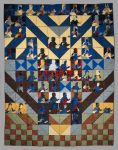
| Bridget Quilt Therese May • San Jose, California, USA In the late 1960s and 1970s, May combined her love of photography and collage to create pictorial quilts using fabrics she purchased at second-hand stores. This work features her daughter Bridget, and references both the traditional quilt format and Warhol’s Pop Art imagery. | |
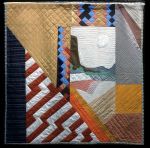
| Where Dreams are Born Joan Schulze • Sunnyvale, California, USA One of several California landscape-inspired quilts created by Schulze in the mid-1970s, the work references traditional quilt blocks but visually and metaphorically looks beyond the patterned foreground to an impressionistic California vista. Like many quilts from the mid-1970s, it illustrates the artist’s urge to apply new designs and techniques while still ▶ | |
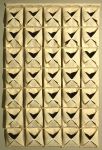
| Pattern of Least Regret Sylvia H. Einstein • Belmont, Massachusetts, USA The “hearts” are created from her husband’s mended socks, and Einstein’s maiden name appears throughout the quilt on laundry labeling strips. During the 1970s, when soft sculpture was in vogue—especially among feminist artists—Einstein was working in this three-dimensional format. Throughout her long career, the grid has been an ▶ | |
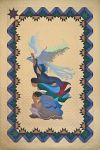
| Cherokee Trail of Tears Chris Wolf Edmonds • Berryton, Kansas, USA Wolf Edmonds was inspired by the story of the Cherokee people who in 1838-39 were forcibly removed from their lands by the Federal government, resulting in the deaths of more than 4,000 Cherokee. Figures represented are Chief Sequoyah, a woman and child epitomizing the persistence required to survive, a male figure representing the despair of the journey, and a phoenix ▶ | |
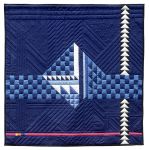
| Steen`s Quilt Charlotte Yde • Frederiksberg, Denmark A graphic designer, Yde has been making art quilts since the late 1970s. Inspired by traditional antique quilts that she saw during a visit to Connecticut when she was 16 years old, Yde taught herself to quilt by reading books since there were no other artists working in this medium in Denmark at that time. This is one of the first art quilts that Yde created. | |
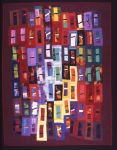
| Warm Light Elizabeth Barton • Athens, Georgia, USA Much of Barton’s work references buildings, especially windows. She is a master at suggesting light. This piece glows because of the contrasting dark and light colors. The fairly minimal quilting is typical of this period. It ties the work together visually but plays a subsidiary role to the pieced top. | |
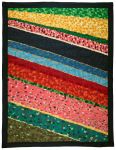
| Flowerseed Farm Holley Junker (d.) • USA Junker uses her innovative pointillist technique--small pieces of pinked or frayed fabrics, layered and stitched—to create a feast of color, depth, texture, and theme. Her depiction of a northern California flowerseed farm is an investigation of light and texture. | |
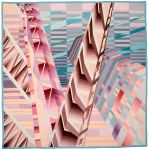
| Clear Palisades Linda MacDonald • Willits, California, USA In the 1970s and early 1980s, MacDonald created large abstract dimensional pieces. She admired the work of painter Al Held, who between 1979 and 1985 also created large-scale abstract paintings with illusionary space. Like Held, MacDonald was interested in creating “another world.” | |
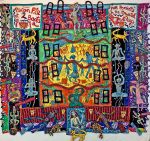
| Tropical New York Susan Shie • Wooster, Ohio, USA $30000 Buy Now » SAQA is pleased to include an early piece by Shie documenting her life in pictures, with only a few scattered phrases and labels, very much unlike her mature style of diary quilts. Created to document a time from January through July 1988 when Shie was living in New York City, working in an Artist-in-Residence program at PS #1. It contains references to events and ▶ | |
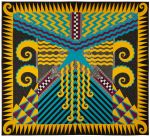
| Divine Radiation Jane Sassaman • Harvard, Illinois, USA An early exploration of the stylized natural forms that continue to inspire her work, this quilt showcases waves, sharp triangles, and spirals in a symmetrically mirrored design. The triangles of the motifs here return as thorns in Sassaman’s later works, the spirals as fern fronds, and the waves as intertwining stems. | |
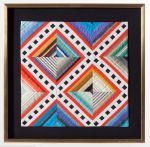
| Study #11 Nancy Crow • Baltimore, Ohio, USA Typical of Crow’s early work, this study is based upon a carefully planned geometric structure. The artist says, “I was always good at mathematics and I love engineering structures.” Note the use of commercially printed fabrics and hand stitching. Later the artist switched to using her own hand-dyed fabrics exclusively to create her pieces and now ▶ | |
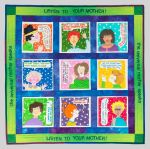
| Listen to Your Mother Jean Ray Laury (d.) • USA There are few twentieth-century artists who can match the breadth and depth of Laury’s influence. This California artist revitalized the field of quilt making and encouraged design originality. In her book Quilts & Coverlets: A Contemporary Approach (1970) she wrote, “If we can retain the structural integrity of the traditional quilt, and add to it a ▶ | |
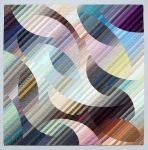
| Michael James Bouree • Lincoln, Nebraska, USA Known for his exploration of curved line, in this piece James’s use of light-dark curvilinear shapes echoes the rhythm of the bourée, a French dance from the seventeenth century famous for its sprightly double-time steps. Rhythms of the dance, reflected in this quilt, appealed to composers such as Handel and Chopin. | |
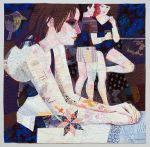
| Star Leslie Gabrielse • Rotterdam, Netherlands Trained by the Academy of Art in Rotterdam, Gabriëlse uses commercial fabrics, with a wide range of motifs and textures, to create everyday pictorial scenes. He has worked in the appliqué technique, often embellished with acrylic paint, since the late 1960s. | |
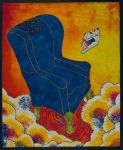
| Blue Book on Blue Chairs Laura Wasilowski • Elgin, Illinois, USA $8000 Buy Now » Self-styled dean of the imaginary Chicago School of Fusing, Wasilowski has perfected the technique of heat fusing in her whimsical art quilts. Her representational imagery usually has an original twist, such as the cloud-like formations in Blue Book on Blue Chairs. | |
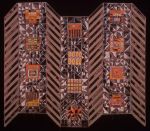
| Iconostasis Patricia Malarcher • Englewood, New Jersey, USA $8000 Buy Now » This artist enjoys testing the limits to which a pattern can be disrupted and still maintain its integrity. After discovering the reflective qualities of Mylar a few decades ago, Malarcher has created numerous geometric quilts that play with light and shade, many of them having a ceremonial feel, like Iconostasis. | |
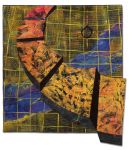
| North Is Up Ann Johnston • Lake Oswego, Oregon, USA $11800 Buy Now » Inspired by landforms and nature, Johnston brings a decades-long career of surface design experimentation to her work. This piece uses both painting and printing with fabric dyes. Freehand construction, rather than designing on paper, characterizes her work from this period. | |
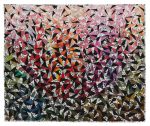
| The Holy Grail Olga Prins Lukowski • Molenschot, Netherlands $1500 Buy Now » Creating textile art for more than thirty years, Prins Lukowski explores the interplay of color against the repetition of geometric shapes. Part of her Puzzle Pieces series, this work intertwines several varying color gradients to move the light from top to bottom across the surface. | |
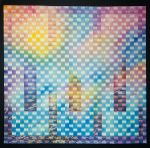
| Winter Elizabeth Busch • Glenburn, Maine, USA Busch is fascinated by the contrast of painted surface with hand quilting stitches. Airbrushing allows the artist to create with great precision but requires some distance from the surface. Quilting by hand brings the artist into intimate contact with her art. This piece is part of a series celebrating the seasons in New England and exploring the artist’s ▶ | |
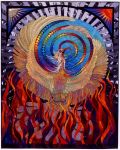
| New Dawn Caryl Bryer Fallert-Gentry • Port Townsend, Washington, USA SOLD By dyeing and painting her fabrics, Fallert-Gentry closely controls the color and tones of her materials, resulting in art quilts full of movement and luminosity. New Dawn depicts the mythical phoenix, being reborn from the flames of its predecessor. As can be seen in this quilt, Fallert-Gentry is an expert at the challenging technique of curved piecing. | |
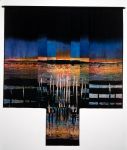
| La Briere Judith Content • Palo Alto, California, USA $13000 Buy Now » La Brière epitomizes Content’s definitive style that has evolved over her forty-year career. The artist assembles strips of her arashi-shibori discharged, dyed, and over-dyed silk panels into kimono shapes, which she then quilts by machine or hand. Content’s work is inspired by landscapes—oceans, marshes, lakes, desert, sky—and often ▶ | |

| Artifact #22 Tim Harding • Stillwater, Minnesota, USA $4800 Buy Now » Harding builds up layers of fabrics and then cuts through them to reveal layers of color, “freeing” the textile from its woven grid to create compelling texture and depth. While his art quilts often result in fragmented figural imagery, Artifact #22 is pure abstraction, with only a hint of a cast-off garment. | |
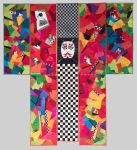
| Come Again Kabuki Yvonne Porcella (d.) • USA Long fascinated by world textiles, Porcella frequently used the kimono shape in her work. When hung together, these five separate panels represent the shape of the kimono. Kabuki theater, known for its elaborate costumes and dynamic acting, is echoed in Porcella’s improvisational raw-edge applique that incorporates silk and cotton fabrics in a riot of color and ▶ | |
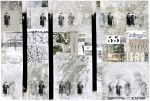
| Journey Linda Colsh • Middletown, Maryland, USA $5000 Buy Now » Journey is among this artist’s extensive series on aging, isolation, and society, in which she questions canonical ideas about beauty. She works with street photographs capturing the lone individual in a private moment, interpreting the image for her quilt through repetition and tonal variation. | |
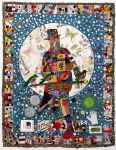
| Moonlight Jane Burch Cochran • Rabbit Hash, Kentucky, USA Famous for her lavishly embellished surfaces, Cochran focuses her narrative imagery within a background of random patchwork, transforming mundane objects, especially buttons and gloves, into a magical surface. | |
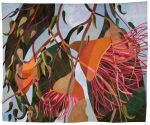
| Not Even Solomon Ruth De Vos • Perth, Western Australia, Australia De Vos is inspired by life around her. Her early work, such as this piece, focuses on plant life. More recent pieces find inspiration in her family of young children. All of the elements in this art quilt are pieced, not appliquéd. Note how the tangle of stamens is repeated in the background quilting. | |
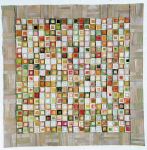
| The Story of My Life Misik Kim • Seoul, Korea A professional fiber artist since the 1980s, Kim is a teacher at the Sookmyung Women’s University Museum in Korea. The artist’s hand-dyed cottons are combined to create the pattern and rhythm of her daily life. She is inspired by the colors of nature and her joy in experimenting with fabrics. | |
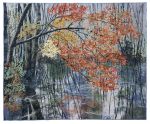
| Radiant Reflections Noriko Endo • Tokyo, Japan $12000 Buy Now » Originally inspired by the Banshu-Ori weaving in her native Japan, Endo created a technique to try to capture the look of oil paintings using fabrics cut into “toothpick-sized” pieces. Endo’s works celebrate the beauty of nature, especially trees. Her quilting designs echo the shapes of the tree leaves. | |
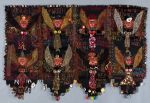
| Angels of Wrath Ulva Ugerup • Malmö, Sweden Ugerup spent her working career as a librarian in Lund, Sweden. Referring to her art as “sewing pictures,” Ugerup prefers to use recycled materials and found objects. This piece is a statement of her strongly held belief that people should be free to express themselves. | |
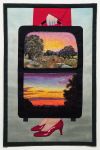
| Traveling From Dawn to Dusk BJ Adams • Washington, DC, USA Adams was a pioneer in what is now called “thread painting.” Trained as a painter, she prefers the flexibility and design possibilities of expressing her art in fabric and thread. She works in both realistic and abstract styles. | |
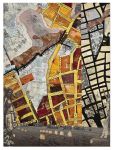
| African Burial Ground II Valerie Goodwin • Tallahassee, Florida, USA With a professional background in architecture, Goodwin conceptualizes cartographic renditions of cities and landscape, from various perspectives. Her interest in archaeology leads to forays into historical sites, often with aerial views distinguished by dense stitching. | |
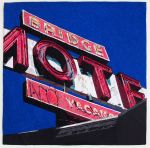
| Bridge Motel Lisa Kijak • Laguna Hills, California, USA This quilt is part of an extensive series exploring the passage of time through the depiction of old neon signs from the 1920-1960s. Based on Kijak’s original photographs, these signs highlight the peeling paint and chipped surfaces, images expressed through raw-edge appliqué and stitch. There are no painted elements. Commercial fabrics create the detailed ▶ | |
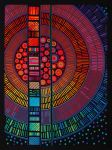
| Geometric Fumiko Nakayama • Kyoto, Japan Based upon the traditional mola reverse appliqué techniques developed by the Guna people of Panama, Nakayama’s work brings her Japanese aesthetic to this art form. Her works attempt to express in color many of the things that she experiences in everyday life. Purely geometric forms, such as we see in this piece, create a powerful visual statement. | |

| Returning to the Source Deidre Adams • Littleton, Colorado, USA A talented photographer and graphic designer, Adams is known for subtle markings and translucency in her quilts. Returning to the Source concerns the natural cycle of trees returning their leaves to the earth, in a quilt shimmering with the colors of autumn. | |
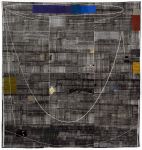
| Fjord Dorothy Caldwell • Hastings, Ontario, Canada Caldwell explores terrains and textures of her native Canada in monumental art quilts. She draws the vocabulary for her art from textile practices, being partial to cloth that suggests mending and the passage of time. Caldwell often sketches lines in her quilts with a batik tjanting tool. | |
|
| American Still Life: The Weight of the Nation The Pixeladies • Cameron Park, California, USA SOLD The Pixeladies (Kris Sazaki and Deb Cashatt) create art work with words and phrases cut from newspapers and magazines, collaged on paper, then scanned and printed on fabric. The resulting whole-cloth quilt is then heavily quilted by machine or hand. The artists combine their keen sense of humor and love of language to make powerful social or political comments. | |
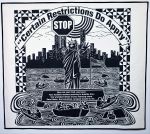
| Certain Restrictions Do Apply Carolyn Mazloomi • West Chester, Ohio, USA Mazloomi’s work explores contemporary social and political themes. From the artist: “Xenophobia and racism are alive and well when we examine immigration reform in the United States….It's an uncomfortable truth: The policy discussion surrounding who deserves to be let into our country is pervasively exclusive….Immigration policy is never ▶ | |

| No Vote, No Voice Alice Beasley • Oakland, California, USA $7000 Buy Now » Like artists working in other media, quilt artists often use the quilt medium to address important social, political, economic, and environmental issues. Beasley’s work refers to a 2013 Supreme Court ruling that resulted in the closure of almost 1,000 polling places, many in African-American communities. The court ruling also resulted in cuts to early voting, ▶ | |

| Regeneration Betty Busby • Albuquerque, New Mexico, USA $3500 Buy Now » Busby trained as a ceramicist. After spending years running a business creating in clay, she turned to fiber art. This piece is part of a series exploring the vessel form in cloth, returning to forms that she had explored in clay. The monumental size gives presence to the sculpture while the materials allow for a variety of surface textures. | |

| Tibetan Treasure Jennifer Day • Santa Fe, New Mexico, USA $3500 Buy Now » Day’s work is based on photographs taken during her travels. The gnarled hands of this Tibetan Buddhist monk, holding his treasured bowl, are emblematic of his quiet dignity and a reminder of the preciousness of simple objects. Bowls serve important purposes in Buddhist rituals, such as water-offering bowls and begging bowls. | |

| Family Life Susan Else • Santa Cruz, California, USA In Family Life, Else deftly portrays the reality of families, where what is going on inside can be very different from what is seen on the outside. Although the bright, cheerful colors and happy, loving poses draw the viewer closer, they contrast starkly with the skeletal forms. On closer inspection, the artist again reminds us of life’s ambiguities with quotes ▶ | |
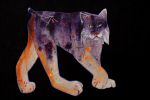
| The Purple Lynx Nancy Erickson • Missoula, Montana, USA $2500 Buy Now » Inspired by prehistoric cave drawings, Erickson has used animal imagery in her quilts since the 1960s. She has become increasingly concerned about our over-crowded planet, with animals forced to share their habitats. As with Purple Lynx, esoteric symbols resembling petroglyphs add texture and mystery. | |
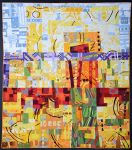
| Spring Equinox Katie Pasquini Masopust • Fortuna, California, USA $11000 Buy Now » During her nearly forty years as a quilt artist, Pasquini Masopust’s background as a painter is evident in all her work, in her mandala designs from the 1980s, three-dimensional imagery and fractured landscapes in the 1990s and 2000s, to her recent work that incorporates her original paintings. Her mastery of line, color, and shape are evident in this abstract ▶ | |
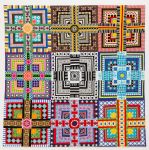
| Wall of Sound Maria Shell • Anchorage, Alaska, USA Relying on the traditional grid, Shell manipulates line, color, and shape with a diversity of fabrics to create her dynamic surface. The grid structure provides a tight framework for the artist freely to explore her intuitive use of color and pattern. | |

| Flora Dianne Firth • Canberra, Australian Capital Territory, Australia SOLD Part of a series exploring forms inspired by her local Australian plants, this piece is designed to explore the potential of light and shade. The shadow patterns are as important to the design as the surface fabric and stitching. Firth is a landscape architect who is passionate about the environment and the urgent need to raise awareness of its fragility. | |

| Home Is Where The Army Sends Us Kristin La Flamme • Portland, Oregon, USA $3500 Buy Now » Part of a large series reflecting on her life as a U.S. Army wife, this piece contrasts the humor of the shopping cart imagery with the stress caused by continual displacement experienced by army families. La Flamme wrote, “The quintessential military spouse is everything to everyone and manages the chaos with a serene smile…. She tries her best to keep it ▶ | |
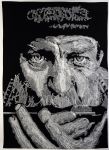
| The Drifter Mary Pal • Almonte, Ontario, Canada $1600 Buy Now » Pal’s artwork is part sculpture, part painting. In the hands of this artist, mundane cheesecloth is transformed into a material that can magically convey imagery and complex human emotions. | |
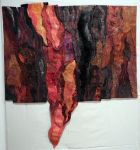
| Pele IV Jenny Hearn • Johannesburg, Gauteng, South Africa $3000 Buy Now » Hearn lives in South Africa and has created a series of works inspired by volcanoes, which includes Ol Doinyo Lengai, a tribute to Tanzania’s volcano Masai goddess Eng'ai. The artist writes, “Volcanoes are a place of regeneration, symbolized by the lichens which help break down the cooled and hardened lava, so that ferns can grow.” Pele is the goddess ▶ | |
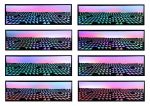
| Light Waves John Lefelhocz • Athens, Ohio, USA $9800 Buy Now » Lefelhocz is known for using unconventional materials and conceptual cross-referencing in his artwork, often incorporating a grid-like structure. Although this quilt embraces traditional quilt making, Lefelhocz maintains his outsider approach by giving viewers a light show. | |
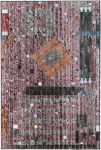
| Pattern Fusion No. 14-Motherboard No. 5 Arturo Alonzo Sandoval • Lexington, Kentucky, USA $20000 Buy Now » As we can see from the materials listed here, Sandoval uses linear industrial materials, repurposing them into his richly textured surfaces. Most of his art quilts feature interlaced structures rather than fabrics, with his series Pattern Fusion aptly describing his technique. |
